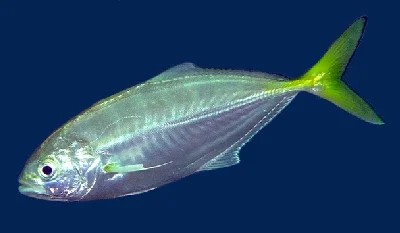Shrimp Scad
Alepes djedaba
The shrimp scad (Alepes djedaba), also known as the slender yellowtail kingfish, is a species of tropical marine fish belonging to the Carangidae family. Its distribution spans the tropical and subtropical regions of the undefined and the eastern 🌊 Pacific Ocean, extending from 🇿🇦 South Africa to Hawaii (🇺🇸 United States), and including 🇯🇵 Japan and 🇦🇺 Australia. Typically found on inshore reefs and sandy substrates, the shrimp scad exhibits a body profile characteristic of the scad family, which can make it difficult to distinguish from other species within the Alepes genus. This species is notably larger than other scads, reaching up to 40 cm in length, but often observed at smaller sizes. The shrimp scad is carnivorous and frequently forms large schools, feeding on a diverse range of crustaceans and small fish. While it holds moderate importance to fisheries across its range, it is particularly valued in certain regions.
The shrimp scad is distinct for its relatively large size among scads, attaining a maximum known length of 40 cm, though more commonly measuring around 25 cm. Its body features an oblong, compressed shape with nearly symmetrical convex dorsal and ventral profiles. The snout is pointed, and the eye diameter closely matches the snout length, featuring a well-developed adipose eyelid on the posterior half. The species has two moderately high, separate dorsal fins; the first comprises eight spines, while the second has one spine followed by 23 to 25 soft rays. The anal fin comprises two detached spines and another spine connected to 18 to 20 soft rays. The lateral line's anterior section is prominently curved, containing 31 to 36 scales, while its straight section consists of 77 to 85 scutes.
In terms of coloration, the shrimp scad exhibits an overall silver hue with a green-blue tone on its upper body, transitioning to a white underside. A diffuse dusky blotch is present on the operculum margin, bordered by a smaller white spot. The spinous dorsal fin and the last dorsal fin spine are often blackish or dusky, with a similar coloring above the scaly sheath of the soft dorsal fin. The middle portion of the anal fin is slightly blackish or dusk below the scaly sheath. The caudal fin frequently displays a vivid yellow color, especially when fresh, with the upper caudal lobe darkening. After removal from water, the posterior scutes may appear yellow to rusty in color.
The shrimp scad is prevalent in the Indo-Pacific region, ranging from the 🌊 Red Sea and East Africa to the Hawaiian Islands, as well as extending north to 🇯🇵 Japan and south to 🇦🇺 Australia. Historical records indicate its presence in the Mediterranean Sea since 1927, expanding to areas such as the 🌊 Aegean Sea, 🇪🇬 Egypt, Libya, 🇹🇳 Tunisia, and the Marmara Sea. Primarily an inshore species, it inhabits reefs and open sand patches, including moderately turbid waters, and often aggregates in large schools. Occasionally, it is found near shore in surf zones and estuarine waters, indicating a pelagic lifestyle in certain scenarios.
The shrimp scad is recognized as a migratory species, with studies from 🇮🇳 India suggesting seasonal residency and feeding in Madras' waters from September to May, followed by migration for spawning purposes. Its diet shifts as it matures, with older specimens predominantly consuming young fish, decapods, ostracods, amphipods, and cladocerans, and smaller amounts of nematodes and insect matter. Variations in dietary preferences are evident across different size ranges. The species is classified as an active midwater feeder, with reduced feeding activity noted during the breeding season. Sexual maturity is generally reached by approximately 17 cm fork length, with spawning believed to occur in shallow coastal waters.
Economically, the shrimp scad holds moderate commercial interest in most regions, often deemed too small for substantial commercial efforts. It is commonly caught as bycatch through hook and line tackle and seine nets. In 🇮🇳 Indian fisheries, it represents 43% of the carangid catch in purse seines but is infrequently captured by trawls or gill nets. Traditional fishing methods, such as inter-tidal fixed stake traps, also yield the shrimp scad in subsistence fisheries. Along the Asian and 🇮🇩 Indonesian coasts, it is more frequently targeted and appreciated as a desirable food fish.
Comments
Please, sign in to leave comment
No Comments yet
Last Update: May 28, 2025

